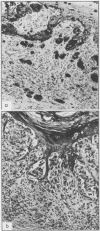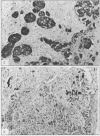Abstract
The monoclonal antibody NK1 C3, synthesised by the Netherlands Cancer Institute, has been used to assess its value in the diagnosis of melanocytic lesions. The antigen recognised by this antibody is not denatured by formalin fixation, with the result that the antibody can be used for retrospective studies on conventionally processed material. Positive results were obtained in primary melanoma (18/18), secondary melanoma (21/21), junctional and compound naevi (32/32), intradermal naevi (9/12), congenital naevi (3/3), so called dysplastic naevi (13/13), blue naevi (5/5), and Spitz tumours (3/14). Non-melanocytic tumours were tested for comparison. The results showed relative but not complete specificity of the antibody for melanocytic tumours, with positive results only in breast and prostate tumours (2/6 and 2/5 respectively). Negative results were obtained with basal and squamous cell carcinoma, appendage tumours, neural tumours, and apudomas. The staining pattern of NK1 C3 was compared with that of antibodies to S100 protein and to neurone specific enolase. Compared with S100 protein NK1 C3 gave stronger staining of a higher percentage of cells in the 12 specimens in which a direct comparison was made. Antibody raised against neurone specific enolase in sheep gave very poor results with heavy background staining. We suggest that NK1 C3 is a useful addition to the battery of monoclonal antibodies of value to the diagnostic histopathologist.
Full text
PDF





Images in this article
Selected References
These references are in PubMed. This may not be the complete list of references from this article.
- Dhillon A. P., Rode J., Leathem A. Neurone specific enolase: an aid to the diagnosis of melanoma and neuroblastoma. Histopathology. 1982 Jan;6(1):81–92. doi: 10.1111/j.1365-2559.1982.tb02704.x. [DOI] [PubMed] [Google Scholar]
- Gaynor R., Herschman H. R., Irie R., Jones P., Morton D., Cochran A. S100 protein: a marker for human malignant melanomas? Lancet. 1981 Apr 18;1(8225):869–871. doi: 10.1016/s0140-6736(81)92142-5. [DOI] [PubMed] [Google Scholar]
- Nakajima T., Watanabe S., Sato Y., Kameya T., Shimosato Y., Ishihara K. Immunohistochemical demonstration of S100 protein in malignant melanoma and pigmented nevus, and its diagnostic application. Cancer. 1982 Sep 1;50(5):912–918. doi: 10.1002/1097-0142(19820901)50:5<912::aid-cncr2820500519>3.0.co;2-u. [DOI] [PubMed] [Google Scholar]
- Nakazato Y., Ishizeki J., Takahashi K., Yamaguchi H. Immunohistochemical localization of S-100 protein in granular cell myoblastoma. Cancer. 1982 Apr 15;49(8):1624–1628. doi: 10.1002/1097-0142(19820415)49:8<1624::aid-cncr2820490816>3.0.co;2-h. [DOI] [PubMed] [Google Scholar]
- Rode J., Dhillon A. P., Papadaki L. Immunohistochemical staining of granular cell tumour for neurone specific enolase: evidence in support of a neural origin. Diagn Histopathol. 1982 Jul-Sep;5(3):205–211. [PubMed] [Google Scholar]
- Rowden G., Connelly E. M., Winkelmann R. K. Cutaneous histiocytosis X. The presence of S-100 protein and its use in diagnosis. Arch Dermatol. 1983 Jul;119(7):553–559. doi: 10.1001/archderm.119.7.553. [DOI] [PubMed] [Google Scholar]
- Springall D. R., Gu J., Cocchia D., Michetti F., Levene A., Levene M. M., Marangos P. J., Bloom S. R., Polak J. M. The value of S-100 immunostaining as a diagnostic tool in human malignant melanomas. A comparative study using S-100 and neuron-specific enolase antibodies. Virchows Arch A Pathol Anat Histopathol. 1983;400(3):331–343. doi: 10.1007/BF00612194. [DOI] [PubMed] [Google Scholar]
- Stefansson K., Wollmann R., Jerkovic M. S-100 protein in soft-tissue tumors derived from Schwann cells and melanocytes. Am J Pathol. 1982 Feb;106(2):261–268. [PMC free article] [PubMed] [Google Scholar]






